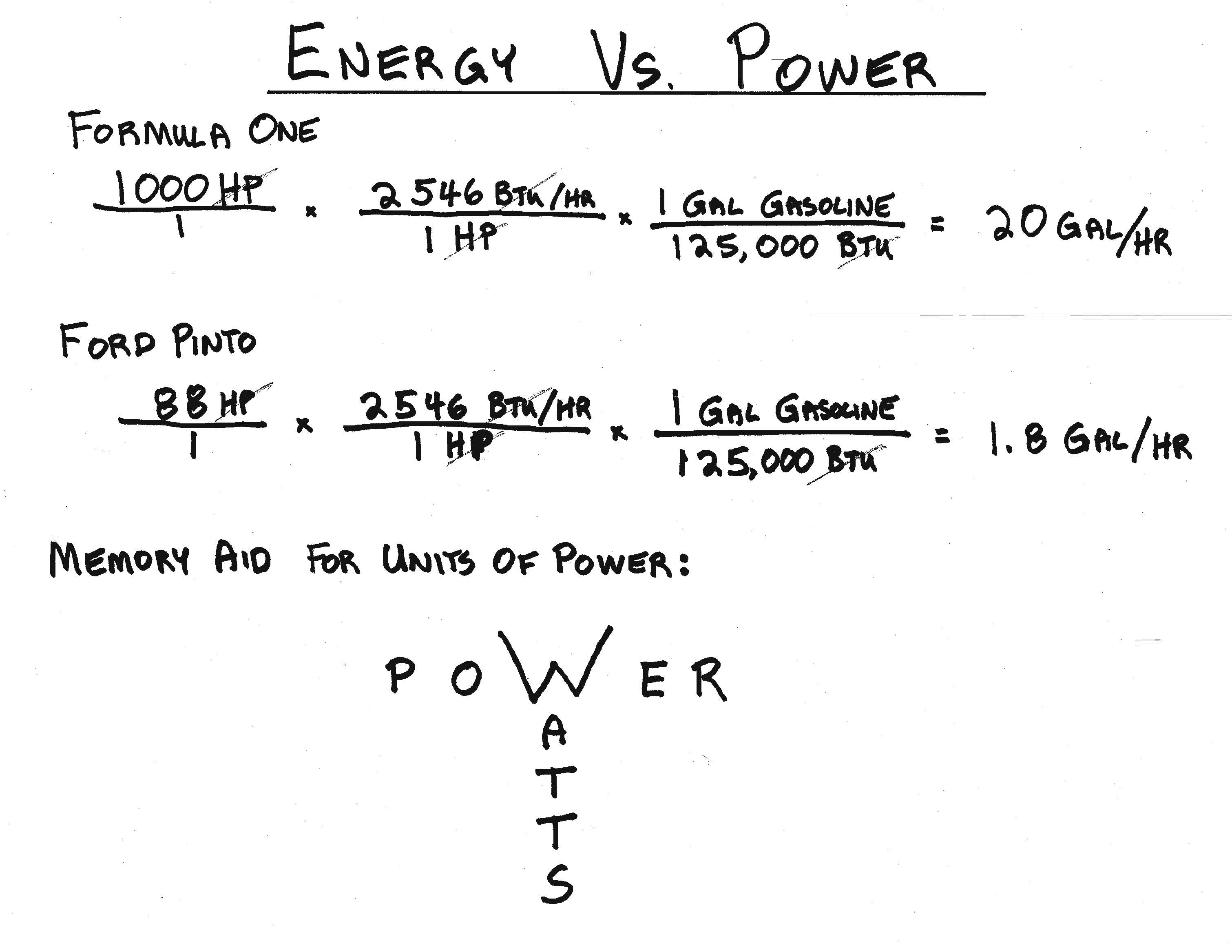 CONSTRUCTION KNOWLEDGE >>
GENERAL TECHNICAL KNOWLEDGE
>>
CONSTRUCTION KNOWLEDGE >>
GENERAL TECHNICAL KNOWLEDGE
>>
BASIC ENERGY
1. Why I Should Know the 3 Laws of Thermodynamics?
2. How does Energy Differ from Power?
3. What are the Basic Energy Unit Conversions?
4. What I Should Know about Heat Transfer: Conduction, Convection and Radiation?
5. Tricks of the Trade & Rules of Thumb for Basic Energy:
Why I Should Know the 3 Laws of Thermodynamics?
The laws of thermodynamics can be comically paraphrased as follows:
- You really can't win.
- It's wishful thinking to think you can break even.
- And you can't even get out of the game.
The actual laws are paraphrased here:
- Energy can neither be created nor destroyed, only altered in form.
- Any engine must be less than 100% efficient.
- It's impossible to reach the temperature of absolute zero.
The first law helps you understand the nature of energy...helps you know that energy doesn't get used up, it changes in form. So when you pour gasoline into a job site generator, you will get electricity, but not up to the full energy level of the gasoline that was used. Some of that gasoline energy goes into heat of exhaust and some into friction, which also produces heat. The amount of energy in that gasoline doesn't lessen, it just takes other forms.
The second law helps us understand that while engines may keep getting more efficient, they will never be completely efficient (100%) and certainly never be "perpetual motion machines".
The third law doesn't seem to have any practical applications, I just included it because I liked the paraphrase "And you can't even get out of the game".
If you want a more detailed explanation of thermodynamics, go to the US Department of Energy Fundamentals Handbook on Thermodynamics, Heat Transfer and Fluid Flow.
You should understand the basic principle that energy doesn't get used up, it changes form. You will simply understand the physical world better with this knowledge. Honest.
How Does Energy Differ from Power?
Whenever I hear someone on the jobsite using the wrong units (they say pounds of air pressure when they mean psi or they say BTUs when they mean BTUs/hour or BTUs/sec), I think two things. One, they don't really understand what they are talking about. Two, they will be making some mistakes due to that misunderstanding that could be easily avoided. Pet Peeve alert! Learn and use the correct units. It will make you look smarter and save you some aggravation.
So how does energy differ from power? Energy is the ability to do work. 1 BTU heats 1 pound of water 1 degree Fahrenheit. It takes energy to drive your car, heat your house, or charge your battery. Another example: 1 KiloWatt-hour of energy lights a 100 Watt bulb for 10 hours.
I think of power, on the other hand, as capacity. Power is the rate at which energy is used. BTUs/hour, Horsepower and KiloWatts are are units of power. That light bulb has the capacity to use 100 Watts, it's level of power is 100 Watts. The Formula One race car has the capacity of delivering 1000 HP, while a Ford Pinto powers along at 88 HP. The Formula One race car can use energy faster than the Ford Pinto (unless the Pinto is exploding from a rear collision, then that's a different calculation).
So let's do a quick calculation to compare the gasoline usage of the Formula One vehicle and the Pinto. We can easily find that gasoline has an energy value of 125,000 BTUs.

So the energy is in the gasoline (and yes, I know a Formula One doesn't run on gasoline), but the power is the capacity either vehicle has to use that energy over time. When trying to remember the units, the little graphic above about power (having a W) and watts is helpful.
Since I'm working on some solar energy projects, let's try an example from that field. The sun's energy on a given surface is called the irradiance. So that's the energy portion. The power portion is radiation. The radiation is the irradiance measured over time (just like power is energy measured over time). Solar radiation data is measured in KiloWatt-hours per square meter per day. From solar radiation charts, we find a horizontal plane in Harrisburg PA in March gets an average of 3.3 KiloWatt-hours per square meter per day.
To recap, the most common energy units are BTUs, KiloWatt-hours while the power units are BTUs/hour, Horsepower and KiloWatts. The rest of the conversion units are also available on this site.
What are the Basic Energy Unit Conversions?
While the measurement conversions are shown in a detailed way
by following this link (measurement
conversions), it's worth considering the basic energy units. A few energy unit
conversions are worth trying to memorize, just to be able to do some
quick calculations in your head.
1 Kilowatt = 3,413 Btu/hour
1 ton of air conditioning = 12,000 Btu/hour
1 person in a room adds about 250 Btu/hour or the equivalent of a 75 watt light bulb
1 HP (motor) = 746 watts (operating energy)
1 gallon of gasoline = 125,000 BTUs
1,000,000 Btu/hour = 10 therms or 1,000 cubic feet of Natural Gas
= 46 pounds or 10.88 gallons of Propane Gas
= 7.14 gallons of No. 2 Fuel Oil (diesel fuel)
= 293 KW of electricity
The energy unit Btu stands for British Thermal Unit and is defined
as the amount of heat required to raise the temperature of one pound of
water by one degree Fahrenheit. Power differs from energy because power
refers to the rate at which work is performed or energy is transmitted.
So the standard unit for power is Btu/hour. Unfortunately, many times
units of power are also referred to as Btu, instead of the correct
Btu/hour. When evaluating power units, be aware that the term Btu is
often misused when Btu/hour should be used.
![]()
What Should I Know about Heat Transfer: Conduction, Convection & Radiation?
Understanding the basics of how heat transfers will help you in
correctly seeing how buildings get hot and get cold. These simple
building blocks of knowledge will allow you to better evaluate more
complicated systems.
Conduction is a transfer of thermal energy from a region of higher temperature to that of lower temperature. Across a pane of glass, separating the warm interior from the cold exterior, the heat conducts through the glass to the outside. The actual work of conduction occurs by the molecules in the glass moving against each other and transferring the heat. So the molecular structure of the material affects its conduction. A piece of steel conducts heat through it quickly, while a piece of wood more slowly and Styrofoam insulation much more slowly. Therefore, building walls and roofs use insulating materials to slow the heat transfer (of heat during the heating season and cold during the cooling season) so that the building space will be more comfortable and use less energy to condition.
Convection acts as another form of heat transfer, utilizing fluid flow. As the heat transfers through the glass pane described above, the outside air blows across the window, using convection to transfer the heat. In natural convection, the fluid warms, becomes less dense and rises. In forced convection, fans and pumps force the fluid to move and create a heat transfer convection current. When considering the heating and cooling of a building, the cracks around windows, doors, vents, etc. all have convection zipping the heat energy away from the facility.
Radiation transfer heat in quite a different manner than conduction (molecules in a solid bouncing into each other and transferring energy) and convection (a fluid flowing by a surface and transferring energy). Radiation does not need a solid or even a fluid medium to transfer heat. Radiation uses electromagnetic energy waves to radiate energy away from the source. Radiation can work in a perfect vacuum, or through a perfect vacuum. The Sun radiates energy to the Earth through the vacuum of space. Just as insulation slows heat transfer from conduction, radiant barriers reflect radiation back to the object and slow heat transfer. The foil backed fiberglass batt insulation acts as a radiant barrier, with the foil backing reflecting the radiant energy back into the space.
A complete guide to Thermodynamics, Heat Transfer, and Fluid
Flow is provided in a 3-part manual.
Volume I is titled DOE-HDBK-1012/1-92 (June 1992) and is 138
pages,
Volume II is 32 pages and titled DOE-HDBK-1012/2-92 (June 1992),
and
Volume III titled HT-03 is 12 pages.
Tricks of the Trade & Rules of Thumb for Basic Energy:
- 1 ton of air conditioning = 12,000 Btu/hour
- 1 person in a room adds the equivalent of a 75 watt light bulb
- When evaluating power units, be aware that the term Btu is often
misused when Btu/hour should be used.

